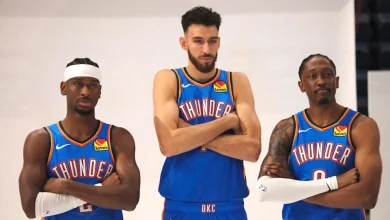‘We clawed at each other’: Just how far women’s surfing – and Layne Beachley – have come

“All of that reinforced our scarcity mentality, which meant that we just saw women succeeding and wanted to pull them down, because they were taking something away from us, as opposed to inspiring us to be better.”
Beachley, 53, is sitting on a rock in the morning sun at Freshwater on Sydney’s Northern Beaches, having indulged this masthead in surfing and splashing about in pristine, half-foot slop on a weekday morning.
The seven-time world champion probably would have done so anyway. But the lack of swell is pushing it, even for someone who surfs pretty much every day once the “briefcase bandits” have cleared the water.
“The girls outnumbered the boys though, didn’t they?” she notes.
Undoubtedly, Beachley is one of the most significant figures behind those women and girls slipping and sliding about, and having a ball on longboards in the Freshwater foam.
So too, the rise of world champions like Picklum and Simmers, and before them, Tyler Wright, Stephanie Gilmore and generations of female surfers pushing for parity in waves and pay – with Beachley the loudest of all.
Molly Picklum and Caity Simmers embrace after a tense final in Abu Dhabi earlier this year.Credit: World Surf League via Getty Images
She has changed her sport for the better, a thousand times over.
Without doubt too, Beachley knows she played her own regrettable part in the different tour dynamic of her time in pro surfing, which started in 1990 and included six consecutive world titles from 1998 to 2003 and another in 2006.
From her first surf contest at age 14 (which she came last in), Beachley had been hellbent on a world title. After the death of the mother who adopted her, Beachley discovered she was adopted and conceived by rape. It left a young Beachley harrowingly deciding, “I wasn’t deserving of love”.
Only a world title would change that in her eyes. Five championships “won through fear” proved it didn’t, but spawned “the compassion of a tiger shark” –an assessment from her competitors and peers that Beachley cites often.
Layne Beachley takes on Tahiti’s famed Teahupo’o break in 2002.Credit: Grant Ellis
A candid recollection in Good Weekend recently detailed a birthday dinner most of her competitors avoided, prompting the then-reigning world champion to ask herself: “Am I the kind of person that people want to hang out with?”
“There are very few women from the tour who, one, are still friends with me and, two, have forgiven me for the [poor] way in which I behaved [back then],” Beachley says, expanding further on the beach at Freshie.
“I believed I had to passionately dislike my competition in order to beat them. I’ve still got peers basically assassinating my character because it was my fault, and that’s a sad indictment of the state of women’s surfing and the generation I came through.
“It was never my intention to hurt or shame or insult. But obviously I did that, and I forgive myself for that. Some people choose not to forgive me for that and there’s nothing much I can do about it.”
With a nod to The Dawn’s emphasis on “challenging the status quo”, Kelly Slater often recalls encountering an unknown woman surfing alongside men at an expression session at Lacanau in France in the early 1990s.
Layne Beachley is the Sport Australia Hall of Fame’s 2025 Dawn Award winner.Credit: Sitthixay Ditthavong
It was Beachley. And in Slater’s eyes, she was the best in the water.
“Why not me? Why not women?” is her simple explanation of taking the lead from surfers like Margo Oberg, Pam Burridge and Lisa Andersen and fighting for further recognition.
Grassroots and women’s pathways flourished under Beachley during an eight-year stint as chair of Surfing Australia.
Picklum first set her eyes on pro surfing at age 14 after a rising star award at Beachley’s talent identification camp.
Molly Picklum, aged 14, with Beachley after attending her juniors camp.
“When I joined the pro tour in 1990, it was a misogynistic, sexist environment that was very unwelcoming for women,” Beachley recalls.
“To know today that my predecessors, my generation and the current generation are continuously fighting that battle to make it a more inclusive, safe and welcoming environment for all, irrespective of gender, fills me with a sense of satisfaction.
“We’ve got such incredible role models like Molly, Sally [Fitzgibbons], Steph Gilmore, Tyler [Wright], Laura [Enever] who understand the opportunity, not obligation, but opportunities they have to drive the agenda – to keep encouraging women and keep pushing for inclusion.
“Surfing’s an environment that’s given me my life, and you can do anything in the water.”
Oscar Piastri honoured with Don Award
Meanwhile, Formula 1 driver Oscar Piastri was presented with the Don Award following a breakout year on the circuit, which included leading the title fight for 15 of the 21 rounds so far.
The award, named after Sir Donald Bradman, is given for achievements deemed to have most inspired the nation, with previous recipients including Ian Thorpe, Shane Warne and Patty Mills.
“Everyone in Australia knows exactly what he [Bradman] represented and the legacy he has in Australian sport, so it’s not lost on me how major this award is,” Piastri said.
“It’s always an amazing feeling to represent our country on the world stage and do well for ourselves.”
The 24-year-old Melburnian sits second in the driver standings behind teammate Lando Norris, having already helped McLaren win their first constructors’ championship since 1998.
“There have been some awesome wins this year, especially at tracks like Bahrain, China and Barcelona where the rate of improvement and pure speed has been very pleasing,” Piastri said. “Zandvoort was also a very cool weekend, achieving the first McLaren grand slam for a long time.”





